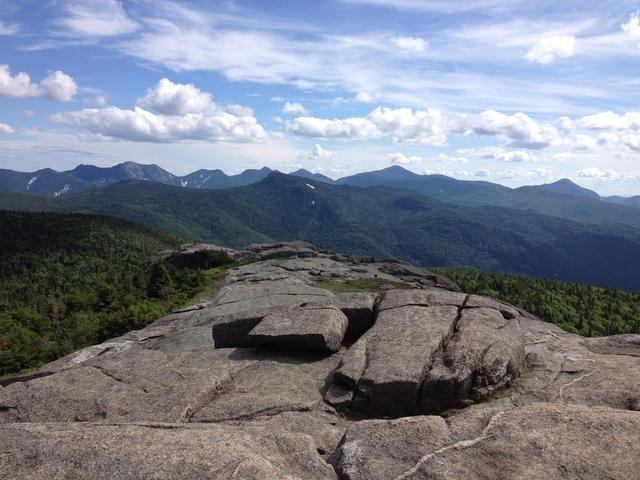Home » Regions » North America » Northern Forests » Atlantic Highlands » Northeastern Highlands » Upper Montane/Alpine Zone
Upper Montane/Alpine Zone
Last updated: August 11th, 2020
↑About the Upper Montane/Alpine Zone
The Upper Montane/Alpine Zone is a region consisting of many discontinuous pieces, encompassing the highest-elevated region of the Northeastern Highlands. It includes the high-elevation regions surrounding numerous isolated peaks, and the region tends to be broader around the taller peaks.This region's climate is a transition between a humid continental climate and an alpine climate at the highest altitudes. The frost-free season is exceptionally short, averaging only 40-80 days. Precipitation is very high. Cloud cover, fog, rime ice (direct condensation of ice onto plants and other surfaces), and wind speed all increase with elevation, as temperatures decrease.
Soils here are shallow and acidic, becoming thinner and absent at the highest elevations.
Only lower elevations are forested. In the Adirondacks, between 2,800 and 3,500 feet, there are mixed forests of red spruce, balsam fir, paper birch, and yellow birch, with understories of mountain ash, mountain holly, and creeping snowberry. In peaks farther east, spruce-fir forest extends to lower elevations (2,500 ft) and has a similar composition but also includes more heartleaf birch, a species that becomes less common farther west.
Above 3,500 feet, mountain paper birch (Betula cordifolia) and balsam fir (Abies balsamea) are dominant up until the tree line around 4,500 feet. Near the tree line, krummholz, stunted and deformed tree growth is found, mostly of balsam fir, black spruce (Picea mariana), mountain paper birch and other birches, Labrador tea, sheep laurel (Kalmia angustifolia), and black crowberry (Empetrum nigrum). These communities on more eastern peaks include rhodora (Rhododendron canadense), which is uncommon in the Adirondacks. Above the tree line, there are alpine meadows, and heath, with mat-forming shrubs and herbaceous plants. Key plant species in the alpine zone include lapland rosebay (Rhododendron lapponicum), northern blueberry (Vaccinium boreale), dwarf birch (Betula nana), pincushion plant (Diapensia lapponica), bog blueberry (Vaccinium uliginosum), bigelow's sedge (Carex bigelowii) and other sedges, highland rush (Juncus trifidus) and other rushes, and various grasses, shrubby fivefingers (Sibbaldiopsis tridentata), mosses, and lichens. Some areas, including the summits, are rocky and barren.
As this region includes the top parts of many different mountain ranges, it tends to be surrounded by different regions in the different areas. In the Adirondacks, most of the peaks in this region are bordered at lower altitudes by the Adirondack High Peaks region, but a few smaller peaks in the southwest are surrounded instead by the Acid Sensitive Adirondacks, a region with a different underlying geology. East of this, in Vermont, many peaks can be found throughout the Green Mountains/Berkshire Highlands. Farther east, in New Hampshire and Maine, peaks of this region are surrounded by the White Mountains/Blue Mountains in the south, and the Quebec/New England Boundary Mountains farther north.
 This photo shows the summit of Cascade Mountain in the Adirondacks, one of the peaks reaching into the upper montane / alpine zone. Barren rock summits are the norm in this region. This particular summit reaches over 4,000 feet. Photo © Laurie Tewksbury, CC BY 2.0.
This photo shows the summit of Cascade Mountain in the Adirondacks, one of the peaks reaching into the upper montane / alpine zone. Barren rock summits are the norm in this region. This particular summit reaches over 4,000 feet. Photo © Laurie Tewksbury, CC BY 2.0.Plant Lists & In-Region Search
We do not yet have data to generate plant lists for a region as fine-tuned as this one. However you can move up to the broader Northeastern Highlands and generate lists for that region: native plants or all plants. Or search that region's plants here:
↑References
1. Bryce, S.A., Griffith, G.E., Omernik, J.M., Edinger, G., Indrick, S., Vargas, O., and Carlson, D. "Ecoregions of New York (Poster)", U.S. Geological Survey (2010) Web.
2. Griffith, G.E., Omernik, J.M., Bryce, S.A., Royte, J., Hoar, W.D., Homer, J.W., Keirstead, D., Metzler, K.J., and Hellyer, G. "Ecoregions of New England (Poster)", U.S. Geological Survey (2009) Web.


